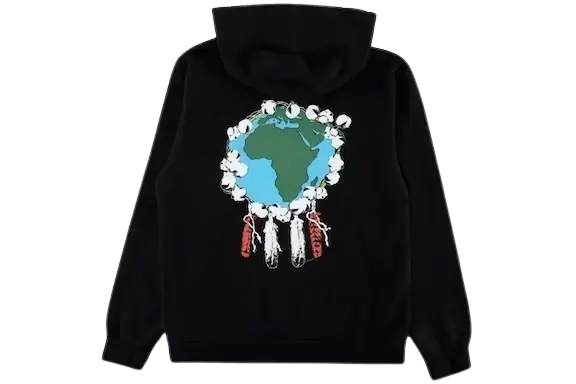In a world where fashion often intersects with culture and identity, Denim Tears founded by the visionary designer Tremaine Emory, has emerged as a powerful voice. Launched in 2019, Denim Tears is more than just a clothing brand; it is a platform that explores and celebrates the complex narratives surrounding Black culture, history, and identity through the medium of denim. With its innovative designs and deep cultural significance, Denim Tears has gained widespread recognition and respect in the fashion industry.
The Vision Behind Denim Tears
Tremaine Emory’s journey in the fashion industry is marked by a commitment to storytelling and social commentary. He has previously worked with renowned brands like Supreme and Stüssy, but it was his personal experiences and heritage that inspired him to create Denim Tears. The name itself is a poignant reference to the emotional weight of the Black experience in America, especially in relation to the fabric of denim, which has its own historical ties to labor and oppression.
Denim has long been associated with working-class culture, but it also carries a legacy of exploitation, particularly in the context of African American history. Emory’s work seeks to reclaim and reinterpret this narrative, weaving personal and collective stories into the fabric of each garment. Denim Tears is a celebration of resilience, creativity, and cultural pride, and Emory aims to evoke conversations about race, identity, and the socio-political landscape through his designs.
A Blend of Culture and Fashion
One of the standout features of Denim Tears is its ability to merge high fashion with cultural commentary. The brand’s collections often incorporate elements that pay homage to African American heritage, including motifs, colors, and fabrics that resonate deeply with the Black experience. For instance, Emory has collaborated with various artists and organizations to create pieces that not only showcase denim’s versatility but also highlight significant cultural references.
The “Cotton” collection is a prime example of this ethos. Launched in 2020, it features denim pieces adorned with bold graphics and messages that reflect the historical context of cotton production in the United States, which is inextricably linked to the legacy of slavery. This collection underscores Emory’s commitment to addressing uncomfortable truths while simultaneously celebrating the cultural richness that has emerged from such histories.
Denim Tears has also made strides in inclusivity, offering a diverse range of sizes and styles that cater to various body types. This focus on representation aligns with Emory’s belief that fashion should be accessible and reflective of the world we live in, thereby allowing more individuals to connect with the brand on a personal level.
Sustainable Practices
In addition to its cultural narrative, Denim Tears is also committed to sustainability. In an era where fast fashion dominates the industry, Emory emphasizes the importance of ethical production practices. The brand prioritizes the use of organic and sustainable materials in its collections, ensuring that each piece is not only stylish but also environmentally friendly. This commitment to sustainability resonates with a growing consumer demand for transparency and ethical responsibility in fashion.
By producing limited quantities of each design, Denim Tears also challenges the conventional model of fast fashion, encouraging consumers to invest in quality over quantity. This approach not only minimizes waste but also fosters a deeper appreciation for the craftsmanship and artistry involved in each garment.
Collaborations and Cultural Impact
Denim Tears has garnered attention not only for its standalone collections but also for its impactful collaborations. The brand has partnered with prominent figures in art and music, such as Virgil Abloh and Lil Uzi Vert, further amplifying its message of cultural significance. These collaborations have allowed Denim Tears to reach wider audiences and explore new creative avenues while staying true to its core values.
The brand’s impact extends beyond the fashion realm; it serves as a catalyst for discussions about race, identity, and the role of culture in contemporary society. Emory’s work has sparked conversations around the representation of Black designers in fashion and the importance of narrative in design. By infusing his collections with historical context, Emory encourages consumers to engage with the stories behind the clothing they wear, fostering a deeper connection to the culture it represents.
The Future of Denim Tears
As Denim Tears continues to evolve, the brand remains dedicated to its mission of celebrating Black culture and history while pushing the boundaries of fashion. Emory envisions a future where fashion serves as a medium for dialogue and understanding, allowing individuals to express their identities authentically. By championing diversity and inclusivity, Denim Tears is poised to inspire a new generation of designers and consumers who value cultural narratives in their fashion choices.
In recent years, the brand has expanded its offerings to include home goods and accessories, further diversifying its product range while maintaining its commitment to storytelling and cultural significance. This expansion reflects Emory’s belief in the power of design to transcend traditional boundaries, inviting consumers to incorporate meaningful narratives into every aspect of their lives.
Conclusion
Denim Tears stands as a testament to the power of fashion as a vehicle for cultural expression and social commentary. Through Tremaine Emory’s vision, the brand has redefined what it means to wear denim, transforming it from a mere fabric into a powerful symbol of resilience and identity. As Denim Tears continues to grow, it will undoubtedly play a pivotal role in shaping the future of fashion, one that prioritizes cultural significance, sustainability, and inclusivity. In a world hungry for authentic narratives, Denim Tears offers a refreshing perspective, reminding us that every piece of clothing carries a story worth telling.
